Garmin Varia: Permission to Ride Outside
I can’t express the theme of the Garmin Varia any better than a Slowtwitcher did on our Reader Forum. It, “actively tells you when vehicles are coming, how many are coming, relatively how far apart they are, and how fast they are closing. And, the Varia typically sees vehicles much further back than you can see in a mirror.”
Got it?
Sounds like a no-brainer. Still, the Garmin Varia radar remains a polarizing piece of gear, as our Reader Forum folks demonstrate. For some reason, strapping a radar transceiver/antenna unit on to the seat post of your bike just gets folks stirred up, and responses to this tech range all the way from “useless waste of money” to “literally won’t leave home without it.”
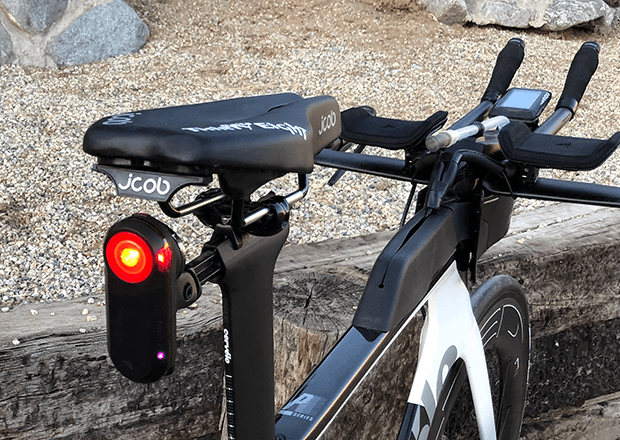
I’m always intrigued by such reactions, so I laid my $199.99 down on the table and walked out with a box full of plastic, blinking lights, and rubber bands. In other words, the Garmin Varia RTL510.
The Garmin Varia Radar takes the form of a slightly enlarged blinky tail light with a power/mode switch on the top, and a micro USB port on the back, nicely shielded from the elements by a rubber(y) flap.
I’m hoping for an update to the Varia that incorporates a USB C interface rather than micro, but Garmin is certainly not alone in continuing to push out units with this ubiquitous, but not fully current, interface standard (Wahoo Fitness took a lickin’ when it intro’d its ELEMNT ROAM less than a year ago, also without the USB C port).
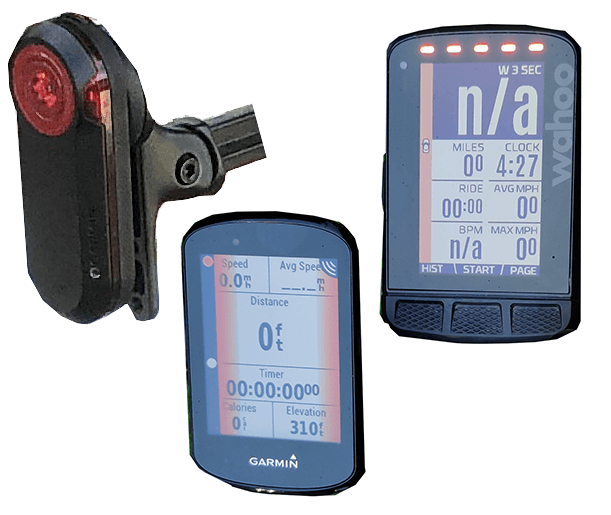
The unit has a ¼ turn mount interface on the back, identical to the ones that you’re probably accustomed to seeing on Garmin head units. Just like those head units, the Varia comes with a plastic mount that attaches to the light/radar via the ¼ turn interface and to your bike via an assortment of shims and rubber bands.
The included rubber bands really don’t seem to interface properly with the mount, and this is less than confidence inspiring when you’re hanging a couple of hundred dollars-worth of electronics off them. I did some asking around, and it doesn’t seem like this is isolated to my particular unit, rather that there’s just something… off… with this mount and the way it interfaces with the bands. I’ve been doubling up the bands just to make myself feel better about things down there…
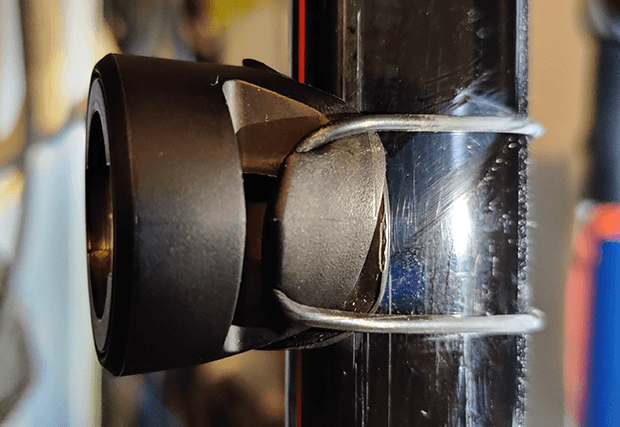
…and so far so good. The system has held fast on all manner of terrain and on a variety of shapes/sizes of seat posts, but I’d still much prefer a better solution, even if it’s just a more secure (looking?) rubber band mount. Our publisher (Dan Empfield) remarked on this as well, but added, “Danged if it doesn’t always stay on the bike.”
There are bolt-on mounts available from Garmin and from some third-party sources, and I’ve got one on a less-used bike, but I haven’t found one that will fit the non-round seat post on my primary bike.
There are also brackets available to mount the radar to one’s seat rails, but the real estate under my saddle is already spoken for. As mentioned earlier, the unit uses a standard Garmin 1/4 turn mount, so it will 1/4 turn it’s way on to anything you can mount a Garmin head unit to. This opens up some interesting possibilities, including gluing a computer mount to the back of a Kam Tail seat post, and I’m working on something like that for my personal bike. Note that the just-published photo essay of a Cervelo P-Series shows a Varia that got its way onto the built-in rear hydration bracket (in the pic highest above).
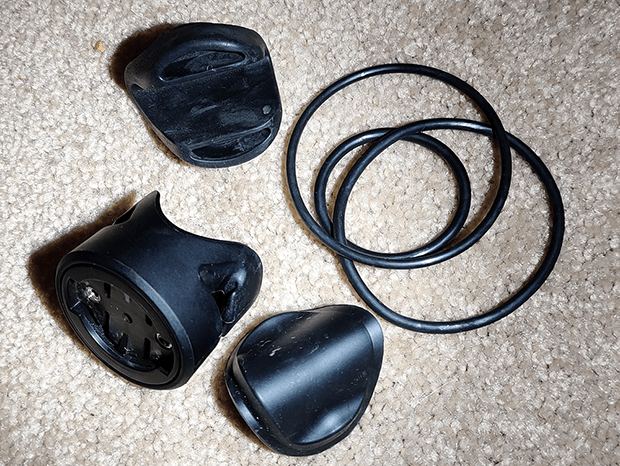
Until something better comes along – or I can get the glue-on mount figured out – I guess I’m fine with the rubber band method. Maybe we can, actually, hope for something better, though? It seems well past time for the bike industry to give some serious thought to incorporating light mounts into the design of bikes. Yes, I’m talking about race bikes too.
You will need some kind of a compatible head unit to make this system work, and the pool of applicants for that position is growing but not comprehensive. Most Garmin head units are compatible of course, but this isn’t a Garmin exclusive deal. The Varia Radar transmits using the ANT radar protocol, and several other brands are supporting the standard with their head units.
I think a measure of the importance of this product is that a head unit is considered by many to be irrelevant if it doesn’t interface with the Varia. Those given to hair-trigger criticism had a conniption when Wahoo’s ROAM was launched last April without that interface completed (a firmware update a few weeks later cured this).

The ANT protocol website has a listing of head units that are compatible with the Varia but it’s incomplete. Wahoo head units are not on the list as of this writing, even tho that firmware update adding Varia function has been out since early last Summer. The Karoo Hammerhead has the radar function. Not on the list. Stages just rolled out Varia support on its head units. Not listed.
If you’re looking for a new head unit and Varia radar support is a priority, you’ll probably want to check with the manufacturer. If you’d like to sync up with your current device, it’s fairly easy to check compatibility on most head units; look for a “radar” category under the ANT+ sync options menu. If you don’t see one, you’re probably out of luck.
Make sure you have the latest firmware for your unit installed when you do this, as at least a couple of brands have just recently included Radar support in their latest revisions.
(On all the images below, these head units were all on my bike, all synced to a Varia, all picking up the same signal. You can see what these head units did with that signal.)
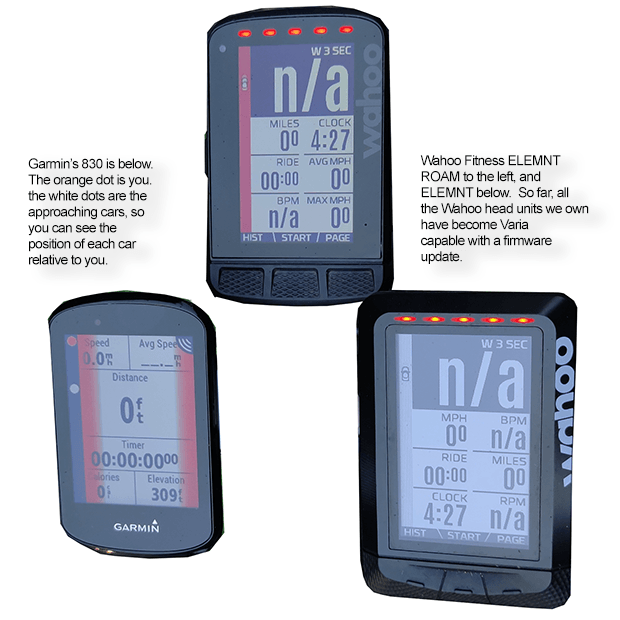
Garmin also offers a stand-alone radar display that you can mount to your bars in lieu of a compatible head unit if you don’t have one or just want a dedicated display. This unit is creatively named the “Varia Radar Display Unit” and it retails at $99.99. We’re not even going to show a picture of it because this is Slowtwitch and… really? You have a Varia but no head unit? Unlikely for this crowd.
How the Varia Radar display looks and to some extent functions on your head unit will vary depending on which head unit you use. I suppose that seems obvious, but I was surprised at just how much difference there is between the implementation of the Radar on the Garmin and Wahoo units I use.
On the Wahoo, when you enable the Radar function a thin band of color appears on the left side of your display screen, pushing the rest of your display a couple of millimeters to the side.
On head units with a B&W display screen, this band is grey (grey is a color, right?)
On a color screen (ROAM), the band changes from green to yellow/orange/red when traffic is detected, based primarily on the speed of the approaching vehicle, but also (or so it appears!) size. Bigger vehicles seem to trigger a red warning at lower speed than smaller ones, at least in my experience. There are also little tiny car icons that travel up the band of color to indicate traffic that’s coming up behind you. The number and relative speed of the icons correlates to the number and speed of the vehicles that the unit detects, and when they get to the top of the screen, they’re passing you. It’s pretty darned intuitive in action.

You can also assign the radar functions to the LEDs on the top and side of the Wahoo units. The top LEDs can be set to duplicate the color change warning of the on-screen display, and the side LEDs can replace the car icon function.
Things are a little bit different on the Garmin head units. When there’s no traffic, there are no “bands” on the screen. There’s a tiny little radar icon in the upper right hand corner of the screen, but that’s it.
Otherwise, your display looks “normal”. As soon as the radar detects traffic, things change. You get two color bands on the head unit (which you can disable if you care to) overlaid on both sides of whatever your screen was showing you before…
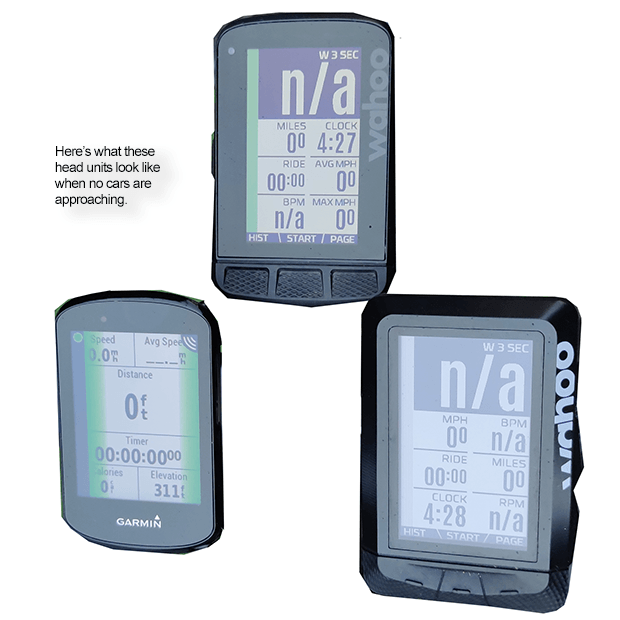
…plus a black traffic indicator band on the left or the right side of the screen; you decide which. Just as on the Wahoo, this band pushes the rest of your display a couple of mm to the side, and it maps out the traffic behind you in the same way, only using little dots instead of car icons. There are, of course, no LEDs on the Garmin, so those options aren’t present.
Having used both the Garmin and Wahoo head units, I can’t say that I really prefer one over the other. Both work equally well, they’re just different. The implementations are close enough to each other in format that I didn’t find switching between them confusing, which is important, I think. I did like the fact that the Garmin method didn’t cut a couple of mm off the side of the map when in GPS mode.
If you’re using a B&W/monochrome display, you lose the “green means clear, red means traffic” function of the display, and I’m not sure this is a trivial disparity. I spent the last couple of rides using a B&W display with the Varia, and – in my experience – it’s simply not as good/useful. With a color display, I really don’t even have to look directly at the darn thing. The red/green status light creeps into the corner of my eye. With the B&W display, I have to look rather closely at the readout to distinguish if there are individual car icons visible. In the circumstances where the Varia is most useful I’d rather not be doing that, and as a result I find myself reverting back to checking over my shoulder on a more regular basis. Those with better near sight may not find it quite as onerous to pick out the individual car icons on a monochrome display, but it is definitely a difference maker for me.
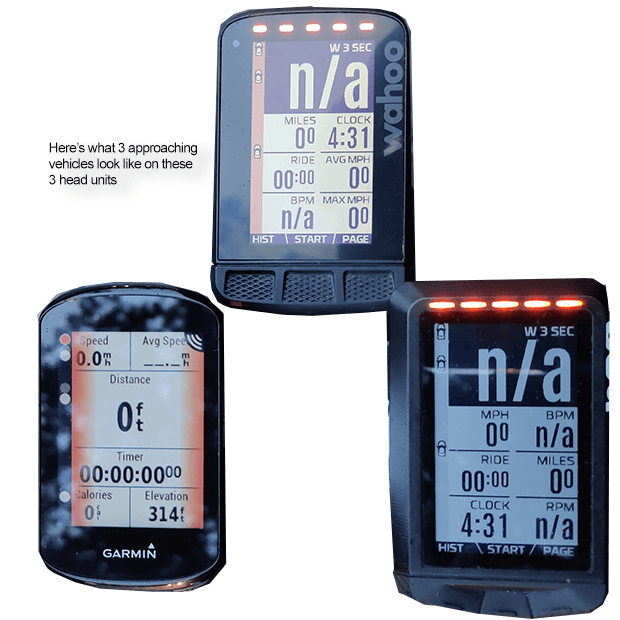
On both the Wahoo and Garmin there’s an audible alert as traffic enters the unit’s zone of detection. You can disable this if it’s too annoying. I don’t find anything annoying that makes me safer, but in group rides in high-traffic areas others may not see it (or hear it) that way.
That zone of detection is huge. The unit will sense cars approaching behind you as they get to within about 150 meters, and it tracks – and displays on the head unit – all the vehicles behind you in that zone (these dots or car icons move up the screen as they approach, as if in a video). You can look down at the display and instantly know not just that there is traffic behind you, but how many vehicles there are, how close they are, and more or less how quickly they’re approaching. Often I’ll look back, and there’s no car. But there is one. I just can’t see it. The Varia often “sees” before you can.
There isn’t any way to adjust the radar function of the Varia. The area of detection, the sensitivity of the unit, the speed/size of an approaching object, and any other parameters used to trigger radar detection are pre-set. What you get when you open the box is what you are going to have, barring future firmware updates. This means that the Varia will pick up the occasional bike, and you can’t turn down the sensitivity to keep that from happening.
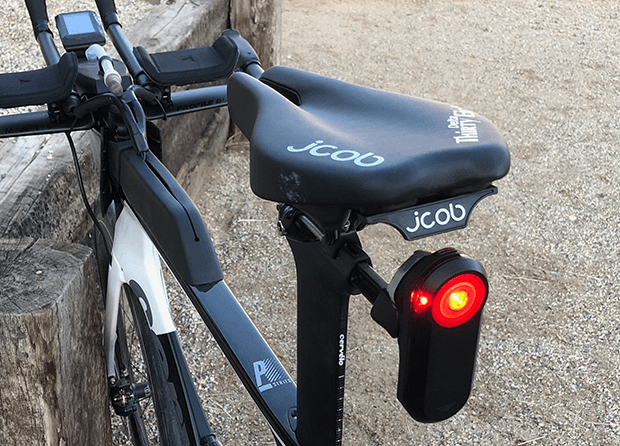
This definitely isn’t the case for the taillight part of the unit. User options abound here, and you get your choice of several flash modes and the ability to control things like brightness and flash pattern remotely via your head unit, and to sync operation with the head unit. Want to have your taillight turn on and off in sync with the timer on your head unit? You can do that. As with the radar functions, the higher-end Varia Light functions aren’t supported by all head units, and this includes the Wahoo I used for most of my testing. As a result, I honestly didn’t spend all that much time experimenting with the more advanced light features. They are there if you want them (and if your head unit supports them) but for most folks you’re buying this unit for the Radar function. The light part is a bonus. That said, the light is bright enough for day use, has a couple of different flash modes and a solid mode, and it’s run time is factored into the 15 or so hours given for the unit as a whole. It’s a good taillight, and you won’t feel like you’re sacrificing to add the radar function to your bike in lieu of whatever you might be using as a taillight currently.
Now, back to the radar! We’ve got a tiny little display, with tiny little icons, tiny little bands of variable color, and (maybe) an audible alert. How useful can this be?
At this point in our review, I know that someone is already cranking out the inevitable response for the comments section that goes something like “I have a mirror on my helmet/handlebar that cost me $.50 and does the same damn thing!” My response to that is, well… cool. I’ve ridden with mirrors on helmet, bars, and attached to my glasses, and try as I might I just never was able to get comfortable with them. It took me a single ride to get used to riding with the Varia, and once you get used to seeing approaching traffic laid out in front of you in an intuitive graphical interface, it can be pretty discomfiting to ride without it. Especially because edge case scenarios seem to be less and less edge case the more I ride.
To paraphrase any number of posters on the forum, “I thought this was a gimmick. Then I tried it. Now I don’t want to ride without it.”
"Can I buy extra mounts so I can run this thing on all my bikes?” Yes and yes.
That pretty much covers the basics of the Varia Radar, but there are some forward looking possibilities that bear mention. You can view Varia Radar info on the Varia Vision. I haven’t had a chance (yet!) to try this out, but throwing the Radar display on to a Heads Up Display is… intriguing.
MyBikeTraffic.com is available on the Garmin App Store and it gives us a sneak peek at what the future might hold data collection-wise for a device like the Varia Radar. There’s an unpleasant yet all-too-familiar backstory to this project that I won’t attempt to summarize, but you can read it for yourself.
Download this app to a compatible device, upload your ride file to the website, and you now have the ability to capture data from all of the individual vehicle detections made by the Radar during a ride. After you upload your data to the site it displays each Radar detection on a map, and not only tells you how many vehicles passed you and where, but how fast they were going when they did so, both in absolute and relative terms.
Pros:
– Radar function really does work as advertised.
– Did I mention there’s a blinky light, too? It’s a good one, bright enough to be useful in daylight riding, with advanced functionality if you have a compatible head unit.
– Radar protocol in the ANT standard means product is compatible with (some!) other manufacturer’s head units.
– Low profile form factor is unobtrusive and combined with (supplied) assortment of shims and bands will fit on the vast majority of bikes.
– Battery life is, in my experience, dead on target with Garmin’s claim of 15 hours. That’s long enough that it’s almost problematic as it lulls me into a false sense of security and I forget to charge the darn thing.
– Possibilities for future applications of the Radar technology are intriguing.
– Price. $199 seems pretty reasonable for a piece of technology like this.
Cons:
– Mounting system. It works, but you’re still hanging $199 off the back of your bike by a rubber band. It sure seems like it’s about time that the bike industry came up with a better answer to rear light mounting…
– Will not work with all head units. But that's increasingly a "con" that attaches to the maker of the head unit, not to Garmin.
And finally, so that everyone knows the lie of the land with this product, we're just finishing a poll on what you all use. Notwithstanding all the pronouncements of folks eschewing the pavement, 95 percent of all Slowtwitchers ride on the road. Of you who do, 1 in 4 are already using a Garmin Varia, and 85 percent of you ride with a red blinker of some sort facing backward (Varia or just a blinker); while 5 percent of you ride with a mirror (by itself, or in tandem with a blinker).


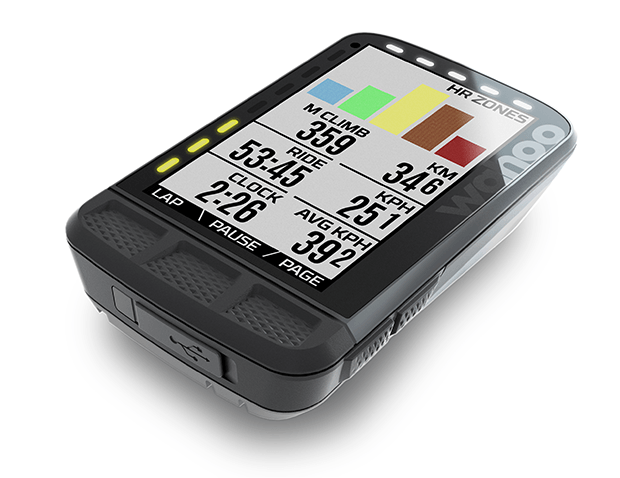
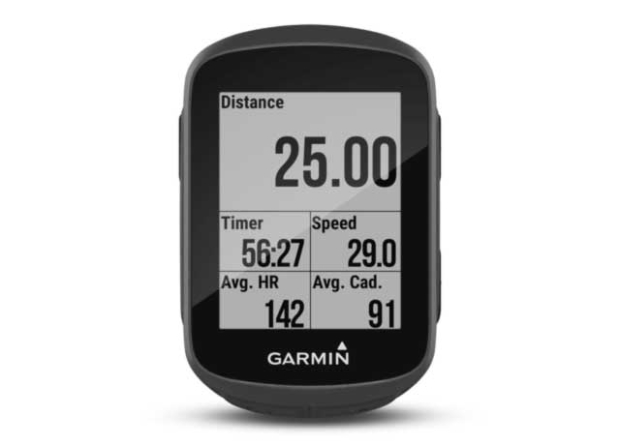
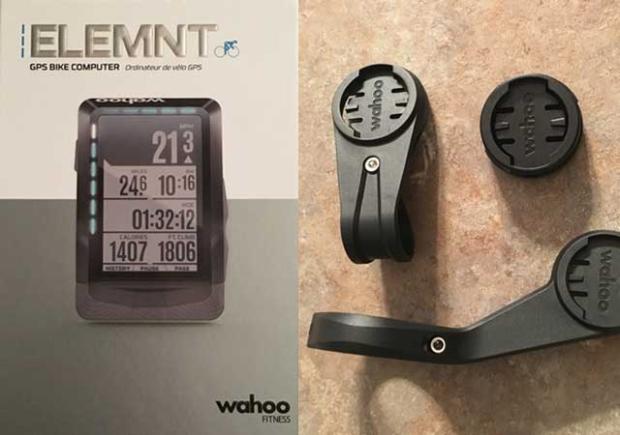
Start the discussion at slowtwitch.northend.network